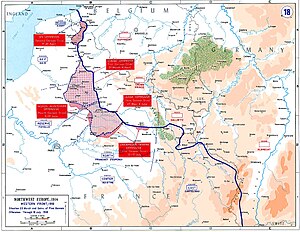Second Battle of the Marne
| Second Battle of the Marne | |||||||
|---|---|---|---|---|---|---|---|
| Part of the Western Front of World War I | |||||||
 German Offensives 1918 |
|||||||
|
|||||||
| Belligerents | |||||||
|
|
|
||||||
| Commanders and leaders | |||||||
|
|
Erich Ludendorff Karl von Einem Bruno von Mudra Max von Boehn |
||||||
| Strength | |||||||
| 44 French divisions 8 American divisions 4 British divisions 2 Italian divisions 408 heavy guns 360 field batteries 346 tanks |
52 divisions 609 heavy guns 1,047 field batteries |
||||||
| Casualties and losses | |||||||
|
|
139,000 dead or wounded 29,367 captured 793 guns lost |
||||||
The Second Battle of the Marne (French: Seconde Bataille de la Marne), or Battle of Reims (15 July – 6 August 1918) was the last major German offensive on the Western Front during the First World War. The attack failed when an Allied counterattack by French and American forces, including several hundred tanks, overwhelmed the Germans on their right flank, inflicting severe casualties. The German defeat marked the start of the relentless Allied advance which culminated in the Armistice with Germany about 100 days later.
Following the failure of the Spring Offensive to end the conflict, Erich Ludendorff, Chief Quartermaster General (he had disapproved of "Second Chief of the General Staff" as a rank) and virtual military ruler of Germany, believed that an attack through Flanders would give Germany a decisive victory over the British Expeditionary Force (BEF), the most experienced Allied force on the Western Front at that time. To shield his intentions and draw Allied troops away from Belgium, Ludendorff planned for a large diversionary attack along the Marne.
The battle began on 15 July 1918 when 23 German divisions of the First and Third armies—led by Bruno von Mudra and Karl von Einem—assaulted the French Fourth Army under Henri Gouraud east of Reims (the Fourth Battle of Champagne (French: 4e Bataille de Champagne)). The U.S. 42nd Division was attached to the French Fourth Army and commanded by Gouraud at the time. Meanwhile, 17 divisions of the German Seventh Army, under Max von Boehn, aided by the Ninth Army under Johannes von Eben, attacked the French Sixth Army led by Jean Degoutte to the west of Reims (the Battle of the Mountain of Reims (French: Bataille de la Montagne de Reims)). Ludendorff hoped to split the French in two.
...
Wikipedia
